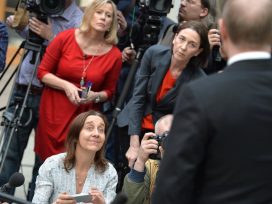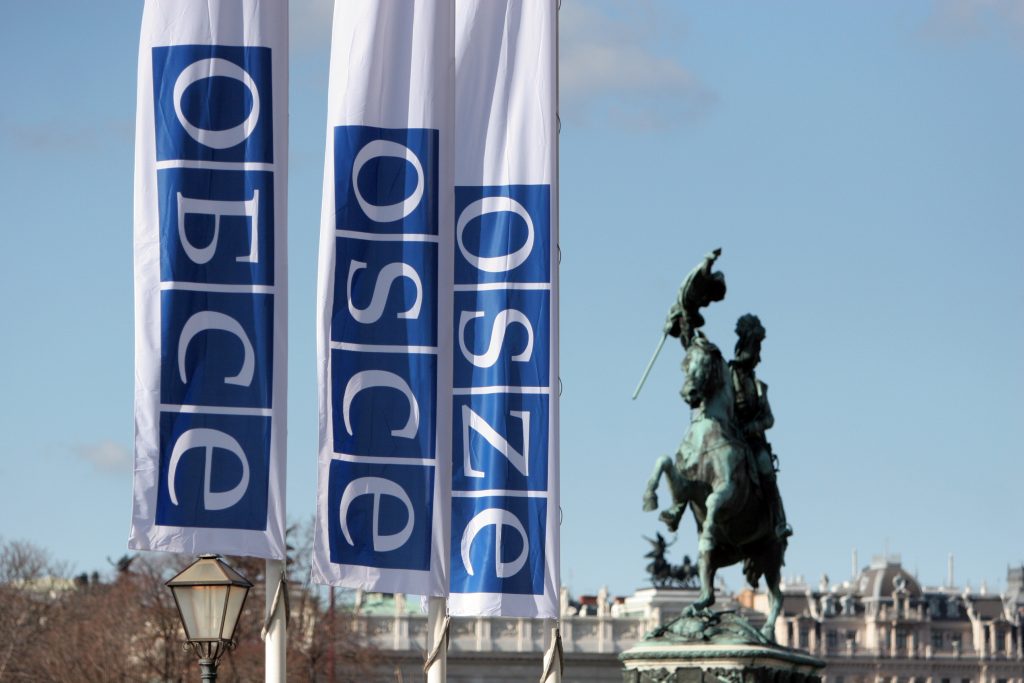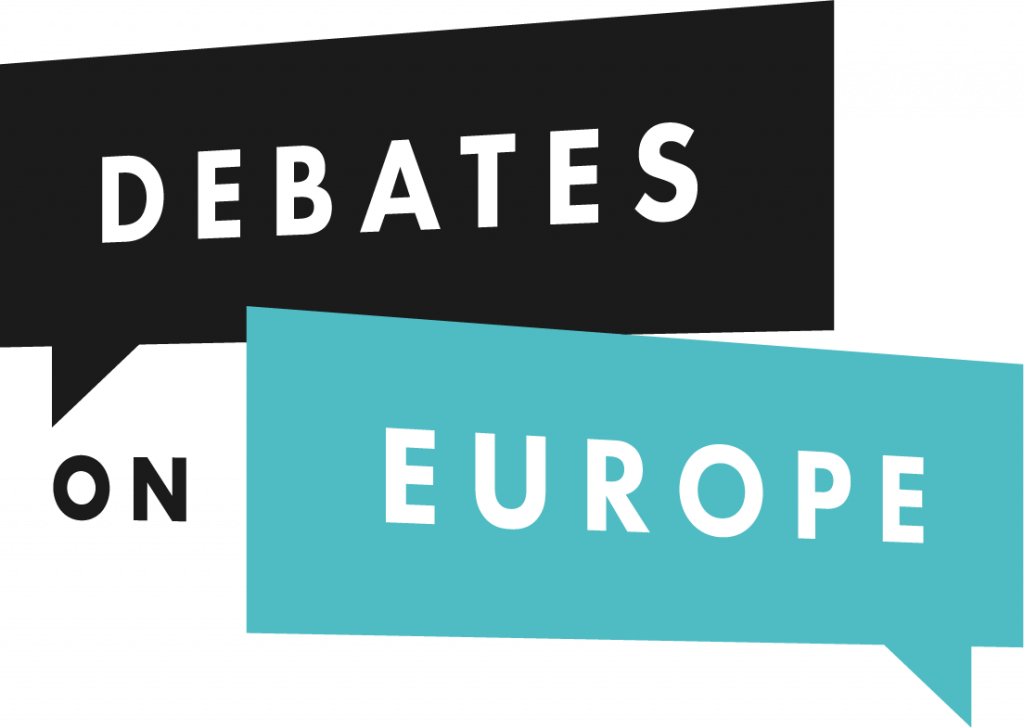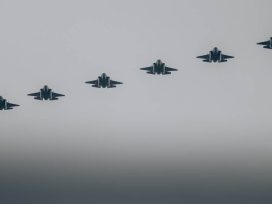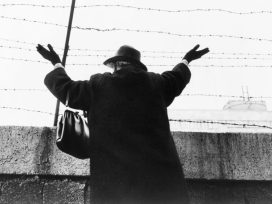Since 24 February 2022, it will have become clear to everyone that Russia has not only challenged but also violated in every respect the European security order embodied by the Organization for Security and Co-operation in Europe (OSCE) and its two founding documents, the 1975 Helsinki Final Act and the 1990 Charter of Paris – the Old and New Testament of this security order.
The most large-scale and brutal act of military aggression in Europe since the Second World War, combined with nuclear blackmail, indicates that we are dealing with a long-term, structural and systemic Russia crisis, affecting international law, the global rules-based order and European security. The significant Chinese support for Russia, and Russia’s military cooperation with both Iran and North Korea, mean that this is far from being a concern for Europe alone. This is not a Ukraine crisis.
The late Soviet Union was essentially a status quo power, focused on consolidating and legitimizing borders, a central incentive for Moscow in Helsinki in 1975. Putin’s Russia is revanchist and revisionist, changing state boundaries according to a colonial and imperialist plan, using large-scale military force, and threatening to employ nuclear weapons. Russia’s external aggression is intimately linked to internal repression, which today has reached almost totalitarian dimensions. This is precisely the type of development that the OSCE’s comprehensive security approach was intended to impede and prevent.
The future of international law, the European security order and the wider European project will depend on whether Russia, the country with the largest number of nuclear weapons and a permanent member of the UN Security Council, is allowed to harvest the fruits of its aggression; whether the Kremlin concludes that the use of force, hybrid warfare and nuclear threats are a successful means of enforcing antagonistic aims and intentions. Moreover, as has become clear since the Trump administration took office, the future will depend on whether Europe is able to withstand the pressure to not only accept but even legitimize what might become a Russian-American ‘deal’.
Since the very beginning, the Conference on Security and Co-operation in Europe (CSCE), and later the OSCE, has been an instrument and a forum for managing relations between Moscow and the transatlantic West. The Helsinki talks were made possible, among other things, by Moscow’s desire to have its post-war hegemony in eastern Europe recognized. The Helsinki Final Act of 1975 was the closest there has ever been to a peace agreement for the Second World War in Europe.
It is therefore worth taking a closer look at Russia’s relationship with the OSCE and the norms and principles on which it is based. What was it that led up to and made possible Russia’s full-scale invasion of Ukraine on 24 February 2022.
The post-war and post-Cold War order
The Helsinki Final Act inspired several movements for human rights, democracy and the rule of law in the Moscow-controlled Eastern Bloc. Helsinki Committees, Charter 77, Solidarność emerged in Central and Eastern Europe, while Sakharov and other underground dissidents gained ground in the Soviet Union as well. In the 1980s, writers such as Milan Kundera, Václav Havel, György Konrád and Adam Michnik turned against the Yalta system, which they saw as holding the Central European states and peoples ‘captive’ in the Soviet prison. National liberation and personal freedom went hand in hand.
Buoyed by the libertarian spirit of the 1980s, the movement triggered by the Helsinki Final Act was an essential part of the force field that made possible the revolution of freedom in Central Europe in 1989 and the fall of the Soviet Union in 1991. The idea took hold of a Europe whole, free and at peace. The forces of history gathered momentum and crushed dictatorships not only in Europe but all over the world. The more philosophically inclined shared Francis Fukuyama’s confidence in a Hegelian end of history. In retrospect, it is hard to imagine how it was possible to consolidate and codify all this in the Paris Charter as early as 1990, a year before the dissolution of the Soviet Union.
The 1990s was a successful decade in European history, healing the wounds of the Second World War and the twin totalitarianisms of Nazism and Communism. The Baltic countries regained their independence, Germany was unified, democracy and market economy were introduced across Europe, albeit not perfectly and smoothly, the EC was transformed into the EU, the neutral countries of Sweden, Finland and Austria became members of the EU, followed later by the dual membership of the Central and Eastern European states in both the EU and NATO. The idea of a Europe growing back together gained momentum. Despite major setbacks, such as the wars in the Balkans, Chechnya, Nagorno-Karabakh, Transnistria, Abkhazia and South Ossetia, the direction of travel seemed clear.
For the inhabitants of central and eastern Europe, the fact that the odious Yalta system had been fought and defeated represented progress. Yalta had allowed the oppression of nations, states and individuals. Moscow’s grip had now been weakened.
It was in this spirit that the CSCE was transformed into the OSCE and a number of basic documents adopted at the same time. The comprehensive concept of security was elaborated further in the 1991 Moscow Document. Several autonomous institutions dedicated to the protection of rights were established and civil society was given the opportunity to hold governments accountable at the annual Human Dimension Implementation Meeting in Warsaw. Field missions were established. The 1990s were the golden age of the OSCE.
The underlying assumption behind this development, whether explicit or implicit, was the idea of normative convergence. Common security was based on the sharing of common norms that were assumed to be universal, with the UN Charter and the UN Declaration of Human Rights as the bedrock. Relativism and identity politics were only just visible on the horizon, as Samuel Huntington discerned in his book The Clash of Civilizations. Sure, there would be bumps in the road, and Russia was certainly a little bit different, but it would eventually follow suit.
That was the idea at least. But we now know that not everyone was happy about this development. KGB Lieutenant Colonel Vladimir Putin, stationed in Dresden at the time, was appalled. But did the West understand what Putin really meant when in 2005 he said that the collapse of the Soviet Union was the greatest geopolitical catastrophe of the twentieth century?
By 2007, however, it should have been clear that normative convergence had now given way to normative divergence. What we assumed to be teething problems (Chechnya, Abkhazia, South Ossetia, Transnistria, the circumstances of Putin’s rise to power in the autumn of 1999, the disagreements over the Western Balkans, especially Kosovo and Bosnia) were now revealing themselves as systemic issues with an emerging ideological framework.
Like during the Brezhnev era, the significance of the outcome of the Second World War, particularly the Yalta system, was increasingly emphasized as a means of identity and legitimacy for the Soviet Union and later the Russian Federation.
The European security order – a concept that emerged after the Second World War and matured with the end of the Cold War – has been brought back onto the agenda since Russia launched its war on Ukraine in 2014. It refers to a deepening and further development of the UN Charter and international law in general. The 1990 Charter of Paris for a New Europe not only developed the comprehensive concept of security but also established the principle of each state’s sovereign right to make its own security and foreign policy choices. This is exactly what is at stake in Ukraine today.
What makes the European security order historically unique is the OSCE’s ‘comprehensive concept of security’, which links conditions within states – especially respect for democracy, human rights and the rule of law – to security between states. The link between internal repression and external aggression is made visible. The idea is that sustainable peace and security can be achieved only by adhering to shared commitments and principles that encompass democracy and human rights.
The 1990 Charter of Paris for a New Europe not only further developed the comprehensive concept of security but also established the principle of each state’s sovereign right to make its own security and foreign policy choices. This is exactly what is at stake in Ukraine today.
Moscow had a fundamentally different view of the world order after the Second World War. While the West emphasized the UN Charter, the Declaration of Human Rights and rules-based cooperation, Moscow saw the Yalta settlement, military force (especially the possession of nuclear weapons) and the veto in the Security Council as the cornerstones of the post-war dispensation.
It was these things that ultimately ensured the ‘righteous’ expansion of the Soviet empire after the Second World War and Moscow’s influence globally. Consequently, the post-Cold War order could increasingly be perceived by Moscow as a loss of prestige, something imposed on Russia in a temporary period of weakness, as a historical injustice that sooner or later needed to be corrected.
In his Munich speech of 2007, Putin clearly stated that this security order was not acceptable to Russia; Moscow instead proposed a so-called European Security Treaty. This would have effectively given Russia a veto over countries’ decision to join NATO and the EU. The 2008 war against Georgia showed that Moscow was prepared to use military force to achieve its political goals. But after Russia launched the war against Ukraine in 2014, Putin’s motto was now ‘new rules or no rules’ – in other words, either rules suiting Moscow or chaos and anarchy. Or simpler still: might is right.
Russia’s objectives versus OSCE principles
Russia has thus been both questioning and violating the basic principles of the OSCE for over 15 years. There are at least four key objectives of Kremlin’s policy that are fundamentally at odds with the OSCE-based order:
First, regime security. This means that democracy and human rights are perceived as an existential threat. This is the case not only where these are defended in Russia itself, but also in Ukraine, which is why the Kremlin began its military aggression in 2014. Second, Moscow wants to re-establish the idea of spheres of influence, increasingly packaging this objective as ‘the Russian world’. In November 2016, Putin said that Russia’s borders do not end anywhere. Third, it is Russia’s outspoken objective to dismantle the European security order, particularly the comprehensive concept of security.
Fourth, the Kremlin hopes to radically change the military balance of power in Europe (by getting NATO and the USA out) and to establish a new European security architecture. In such a system, Russia would be given decisive influence and a veto over the free foreign and security policy choices of other countries. The clearest manifestation of this objective were the draft agreements presented by Russia in December 2021 proposing new security arrangements with the United States and NATO. These proposals were aimed at curtailing countries’ sovereignty and rendering northern and central Europe indefensible, forcing them to bend to Moscow’s will.
To these four objectives can be added a fifth: to undermine once and for all the cohesion of the West and the credibility of NATO. The statements and actions of the Trump administration since February 2025 now suggest that this goal could be achieved. It depends on the willingness of the USA to hold Russia accountable for the latter’s violations of international law, and the USA’s readiness to come to the defence of its European allies in the event of a Russian attack.
A new order can be established de jure, that is in written agreements, or de facto, by the West implicitly accepting new facts on the ground established by military force – for example regime change in Kyiv, forced ‘demilitarisation’ and neutrality. Such tacit acceptance of blatant breaches of the security order would effectively establish a new order based on the use of military force. Another term cherished by Russia for such an order is ‘multipolarity’, a concept recently welcomed by US Secretary of State Marco Rubio.
This is why the issue of accountability – international, political and economic – becomes crucial both in determining breaches of the prevailing security order and maintaining its legitimacy.
‘No fruits of aggression’ is an important principle of international law – or ‘no territorial acquisition or special advantage resulting from aggression is or shall be recognised as lawful’, as it is formulated in a 1970 UN Resolution on ‘Friendly Relations and Co-operation among States in accordance with the Charter of the United Nations’. The international community thus has an obligation not to legitimize violations of international law such as the Russian annexation of Crimea, future Russian control over Ukrainian territory, or restrictions on Ukrainian sovereignty. Failure to hold Russia accountable will present a ‘moral hazard’ in security policy. There is much more at stake than ‘just’ Ukraine’s peace and security.
There are people in the West who claim that the European security order has ceased to exist. However, this exactly what Moscow wants to achieve. After all, it contains the criteria for holding Russia accountable.
How we misread Russia
It should have been clear at least by 2014 that Russia was violating the ten basic principles of the Helsinki Final Act, the so-called Commandments, and that it had been questioning and trying to undermine the OSCE’s commitments long before that. Nevertheless, many have found it difficult to comprehend the full implications of this situation. This difficulty arises primarily because, since the end of the Cold War, a perspective on Russia – and security in general – has prevailed within the OSCE states that is based on false assumptions. As a result, the OSCE has acted hesitantly or inadequately, not least to the Russian aggression in 2014.
The first of these assumptions is that the era of inter-state conflict in Europe is over. At the end of the Cold War, the focus shifted from inter-state conflicts to internal conflicts, where mediation was the obvious means of conflict management. Inter-state conflicts were considered, if not unthinkable, then at least irrational. Ideas from peace and conflict research about conflict cycles moved into practice and influenced the work of the OSCE. This meant that conflicts were seen more as scientific phenomena that can be studied and empirically analysed, following certain typical patterns. No distinction between aggressor and victim of aggression was made when talking about the parties of a conflict.
The second of these assumptions is that to freeze a conflict is to make peace. In the 1990s, Russia had established conflict management formats and precedents constructed in such a way that Russia could ensure that none of the ‘frozen conflicts’ could be resolved without Russia’s consent. Russia was able to instrumentalize these conflicts, for example to ensure that Georgia and Moldova could not develop into fully sovereign, independent states and move closer to the EU and NATO.
The West allowed this to happen in the 1990s, probably because it saw no reason to get involved in Russia’s ‘backyard’, and because it assumed that normative convergence would take its course and that Russia’s instrumentalization of these conflicts was transitory.
From a principled perspective, it can be argued that any OSCE action must aim to restore respect for OSCE principles and commitments. But in the name of negotiating logic and political realities, OSCE conflict management has tended to contribute to constant violations of principles. When Russia’s war against Ukraine began in 2014 it was clear that OSCE hadn’t learned its lesson. By avoiding identifying the actual parties to the conflict, and at least partially redefining the role of the aggressor as a peacemaker, the OSCE contributing directly to the freezing of the situation on the ground along a line of contact, and indirectly to accepting and legitimizing restrictions on Ukraine’s territorial integrity, sovereignty and right to make independent choices.
Everyone wants to find solutions, and everyone wants to achieve de-escalation and stability. But it is important to remember that not all solutions lead to the restoration of respect for OSCE’s principles and commitments. In fact, some solutions only serve to undermine those principles and thereby the European security order. Constructive ambiguity may be a necessary part of the diplomatic toolbox, especially in a consensus-based organisation like the OSCE. But there is a risk that it can be destructive, especially if the problem is not framed correctly.
A further misleading assumption is that conflicts tend to be caused by misunderstandings and unintended escalation. Therefore, a lot of focus was put on so-called Confidence- and Security-Building Measures (CSBMs), dialogue and improved communication. The idea of deliberate escalation or large-scale military aggression against another state was for many an alien concept.
This mindset was given a boost in 2014 by Christopher Clark’s book Sleepwalkers. How Europe Went to War in 1914. Clark’s thesis seemed to be that mistakes and misunderstandings can quickly escalate into a catastrophic world war. For many politicians and commentators, the conclusion was that bloodshed must be stopped as quickly as possible, that conflict be frozen and negotiations opened. Putin and Russia had to be offered ‘off-ramps’.
2014 was also the 70th anniversary of D-Day and the Normandy landings. The diplomacy around these occasions led to Minsk 1 and 2, the Normandy format, the Trilateral Contact Group and other talks. They presented Moscow with an opportunity to let its western partners do its work by getting Ukraine to accept Russian interference in Ukrainian internal affairs. Moscow already had an established toolbox of ways to freeze conflicts, to frame them and set up mechanisms to give Russia full control over outcomes.
The OSCE, under the Swiss Chairmanship in 2014, struggled to deal with the conflict, which it labelled as ‘in and around Ukraine’. Again, it was considered impossible to single out Russia as the aggressor and the party violating OSCE principles and commitments. This exposed the OSCE’s dilemma as a consensus organisation: the OSCE cannot seriously act against a participating state that is clearly in violation of the Helsinki Final Act. Moreover, clearly singling out or criticising Russia was considered by many too provocative, risking escalation.
This leads to another misconception: Russia can be put on the right path and should not be provoked. The reluctance to ‘provoke’ Russia and the willingness to seek dialogue and (unilateral) détente was deep-rooted within both the EU and NATO. The latter, for example, did not start developing concrete defence plans for the Baltic countries until after 2014. The EU adopted a kind of two-track policy, condemning Russian violations of international law on the one hand, and searching for constructive cooperation for mutual benefit on the other. Many EU and NATO countries perceived an internal division of labour, with NATO and the EU being the forums for criticising Russia, and the OSCE as a forum for cooperation and dialogue.
In the broader security policy context, one year after the Georgian war, the Obama administration began its attempts at a reset with Russia. Nordstream 1 was inaugurated in 2011, three years after the Georgian war, and work on Nordstream 2 continued unabated after Russia started the war against Ukraine in 2014. It is fair to say that the West’s signals to Moscow were not characterised by consistency. Even after 2014, the solution was still being mooted to deprive Georgia, Moldova and Ukraine of their sovereign right to make independent security policy choices and to set up a cordon sanitaire, taking into account Russia’s legitimate security interests. Some even suggested that Russia could provide security guarantees to these countries.
Russian narratives and disinformation gained a foothold in the western debate in 2014. The conflict between Russian- and Ukrainian-speakers in Ukraine is eternal; Ukraine is a divided country, or an artificial state; Crimea is actually Russian; Ukraine is ruled by Nazis… In parallel, there was a discussion in many EU and NATO countries about Russia’s ‘legitimate security interests’ and that Russia felt threatened by NATO enlargement, a discussion fuelled by Russian propaganda. The fact that no country bordering Russia had joined NATO since 2004 was easily forgotten, as was the fact that the issue of Ukrainian NATO membership in 2013–14 was a non-issue. All this could be subsumed under the idea that not everything is so clear-cut.
Then there was the notion that the comprehensive concept of security can be neglected. Many actors were and remain unwilling or unable to see the link between, on the one hand, political governance, worldview and ideology (including democracy and respect for human rights), and threats to other states on the other. But this is precisely the link that the OSCE’s unique comprehensive concept of security is intended to address.
Threats are assessed on the basis of perceptions and capabilities, not intentions. Technical as it sounds, the consequences of this assumption were far-reaching. To engage Russia in a dialogue on the new security environment, the OSCE decided to establish a panel of eminent persons at the 2014 Ministerial Council and to launch a so-called structured dialogue at the 2016 Ministerial Council to catalyse conventional arms control and military confidence-building measures. The idea must have been to try to de-escalate the situation and engage Russia in an inclusive dialogue. Both initiatives were unsuccessful. The panel’s report, ‘Back to Diplomacy’, published in 2015, focused on how joint efforts could reduce the concern felt by countries in the buffer zone between Russia and the EU/NATO, ‘the countries in between’. What have proven to be the problem, namely grey zones, cordon sanitaire, buffer zones, were suggested as part of the solution.
Similarly, when assessing threats, state intentions were considered secondary. The discrepancy between what Russia said and how it behaved were not taken seriously enough. What existed were perceptions of threat – something subjective – determined primarily by imbalances of military power. But the threat posed by Russia was not just a subjective perception, as we now know.
In the OSCE context, one Russian argument received particular attention: this was the indivisibility of security, the principle in international relations that holds that no state can strengthen its own security at the expense of others. This has been an argument put forward by Russian representatives whenever Russia’s violation of the basic OSCE principles comes up. The principle has been used to legitimize spheres of influence, in combination with the belief that ‘Russia is partly right’. Here the idea is that Russia should have a veto over whether, for example, a neighbouring country can make agreements with the EU or NATO, since this would threaten Russia’s security.
A ‘balance’, so the argument goes, must be found between the various OSCE principles. This leads to the conclusion that the indivisibility of security and the right of peoples to self-determination (the Crimean referendum) can be invoked in support of Russia’s concerns: ‘you are right about some principles, and we are right about others, and now we have to balance them’. This line of argument has resonated with various OSCE chairpersonships and in some European capitals.
But the OSCE principle of the indivisibility of security can and should be interpreted as an affirmation of the comprehensive concept of security. This would emphasize the importance of the totality of OSCE principles and commitments. What irritates the Kremlin is not only the comprehensive concept of security but also the key principle enshrined in the Charter of Paris: the right of each country to make independent choices of its own security arrangements. This apply equally to all OSCE participating States, hence there can be no spheres of influence.
Both the defenders of the European security order (who see the idea as the necessary basis for security) and its critics (who dismisses it as idealistic and therefore dangerous) have tended to regard the normative order as something essentially separate from, and opposed to, defence capability and military deterrence. In other words, there is a common belief in the primacy of realpolitik. But the reverse argument can and should be made: that the maintenance of order is dependent on (military) force, and that violations of order must be challenged and prosecuted.
In view of the events since 2022, one has to ask whether all the efforts perceived in the leading EU and NATO capitals as de-escalatory and contributing to détente were in fact escalatory and enabled Russia’s decision to launch its full-scale invasion of Ukraine. For a real Zeitenwende to take place, a more self-critical examination of these preconceived assumptions guiding the West’s Russia policy will be needed.
In 2022, the EU and NATO member states harvest the fruits of their collective failure to hold Russia accountable for violations of OSCE principles and the comprehensive concept of security, while at the same time turning a blind eye to the increasing repression inside Russia, which supporters of the realist school of geopolitics anyway considered irrelevant. By playing along with the logic of the frozen conflict, we instead prepared the ground not only for accepting but also for legitimizing the violations of the principles of full and equal sovereignty and territorial integrity implied by the Minsk agreements.
Two different political imperatives have been in conflict here. On the one hand, the urge to avoid further bloodshed and to stop the use of force, even if this meant accepting that OSCE principles and commitments were being violated or disregarded. On the other, the defence of respect for these principles and commitments as a sine qua non for the maintenance of the European security order in the long term. Ukraine is the victim of our lack of imagination, shortsightedness and pragmatic acceptance of compromising principles.
Lessons learned?
What happened on 24 February 2022 was a consistent evolution of processes that have been ongoing for at least 15 years. The war is the most violent expression of a latent Russia crisis that has now become apparent. It is a long-term, structural and systemic crisis.
We are indeed at a historical turning point, a Zeitenwende, one that will define not only what Russia, Ukraine and the rest of eastern Europe will be for generations to come, but also what Europe and the West are. It will set the limits of the European project. Moreover, what we have been seeing since the start of the second Trump administration appears to amount to a second turning point, one that risks undermining international law and the OSCE-based European security order even further.
It is important to remember that war is a means and not an end. It is a means to achieve political objectives. The transformation to another, ‘normal’ Russia – one that is non-antagonistic, non-imperialist and respects democracy and human rights – is further away than ever since the fall of communism. Transformation would require Russia to reckon with its own totalitarian Leninist-Stalinist legacy, its imperialist legacy, and now also this colonial war. Given that since he came to power in 2000, Putin has focused on the writing of history, or rather the falsification of it, such a turnaround is unlikely to happen anytime soon.
The Russia crisis will not end with a ceasefire or the freezing of the war. Russia sees itself as being in conflict with the West and is using its antagonistic hybrid toolbox to enforce its objectives. As long as Russia has a leadership like the present one, which wants to impose existential concessions on Ukraine in violation of international law, peace is not possible.
If Russia were to harvest the fruits of aggression, this would have far-reaching and unacceptable consequences for international law and the European security order, and thus for the security of us all. The Russia crisis is not a problem that can be solved quickly. It must be managed over a longer period of time in something that at best develops into a new cold war.
The OSCE will continue to provide the norms of the European security order and thus the criteria for holding Russia accountable. The OSCE embodies a comprehensive concept of security that forms the basis of a secure and stable Europe. Whether respect for the OSCE’s principles and commitments can be restored is an existential question. If they cannot, the OSCE faces the same fate as the League of Nations before it.
